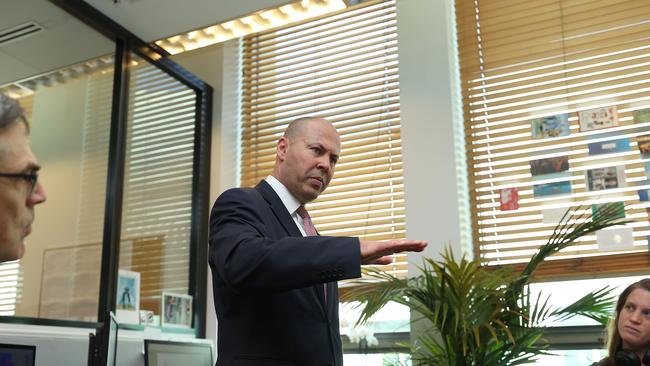
There’s an inherent danger of a coming economic overheat under that scenario that should not be easily dismissed.
Treasurer Josh Frydenberg announced a big spending budget for 2021-22 on Tuesday, rolling out more funds for politically-sensitive areas of the economy like infrastructure, child care, mental health, care for the elderly, while also offering tax relief to low and middle income earners.
The budget aims to support the economic rebound, but it’s mostly a re-election pitch for a government that badly needs a lift in the polls ahead of vote likely within the next year.
In choosing to keep the spending taps open to support what is now the fastest economic recovery in 70 years, Mr Frydenberg has elected not to highlight a long-term plan to rein in ballooning government debt and set a course for a return to budget surpluses over time.
The current fiscal trajectory will bring net government debt to a peak of $980bn, or 40.9 per cent of GDP by 2025. By global standards, that’s still a modest number. But by Australian standards it’s massive, and will unsettle many.
“Australia’s economic engine is roaring back to life,” Mr Frydenberg told parliament in his budget speech. “This budget will ensure we come back even stronger, securing Australia’s recovery.”
Global financial markets were rattled this week by growing fears that inflation might again be unleashed on the world economy, in part due to the buckets of fiscal stimulus now being poured out by the Biden administration to resurrect growth and employment in the US.
There’s a growing tension in the US around inflation risks, amid growing calls for the US. Federal Reserve to start cutting back the size of its government bond purchases.
If the inflation genie does emerge in the US, it will quickly exert itself on the broader world economy through rising supply chain costs. Government bond yields will start to spike up, and consumer inflation expectations will rise.
Inevitably, it will come Down Under.
In Australia, financial markets breathed a sigh of relief when recent first quarter inflation data came in well below expectations. Despite a rapidly tightening job market, there’s no movement as yet on either the dials of wage growth or inflation.
But factor in the closure of international borders due to the COVID-19 pandemic and the stalling of population growth in Australia it may be that spare capacity in the labour market is mopped up much faster than expected, bringing wage increases closer.
Add in the fact that the Reserve Bank of Australia continues to push hard on the monetary policy accelerator while touting policy guidance that interest rate increases are still around three years away “at the earliest.” That has lit up the property market which recently recorded the biggest monthly gain in house prices seen since the 1980s.
The ANZ bank last week also sounded alarm bells when it lowered its forecast for unemployment by the end of 2021 to 4.8 per cent. It warned that such an outcome would seriously challenge the RBA’s dovish outlook.
The National Australia Bank’s monthly survey of business conditions also hit a record high in April, with Alan Oster, the bank’s chief economist and a former head forecaster for Treasury describing the survey data as “simply stunning.”
Still, it might be that the RBA itself is becoming increasingly alert to growing risks of a coming inflation problem.
RBA Deputy Governor Guy Debelle was asked last week after a speech in Perth if he had faith in the RBA’s guidance around interest rate increases being delayed until 2024. He replied saying it would be the “lived experience” within the economy that determines policy decisions at the central bank, not bland long-term forecasts.
Mr Debelle is a savvy central banker and has contributed massively to the critical decisions taken by the RBA in response to the pandemic. Looking into the future, the veteran of the global financial crisis and twin mining booms, who would be first choice to be the next RBA governor, might be growing worried that upon reaching the top job, a nasty inflation shock might be the first thing on his agenda.
Australia’s economic rebound is indeed stunning, and policy makers in Canberra and Sydney may soon need to reckon with it’s aftermath.
James Glynn is economics correspondent with The Wall Street Journal




Australia’s economy is roaring while still hugely dosed up on generous fiscal and monetary stimulus.